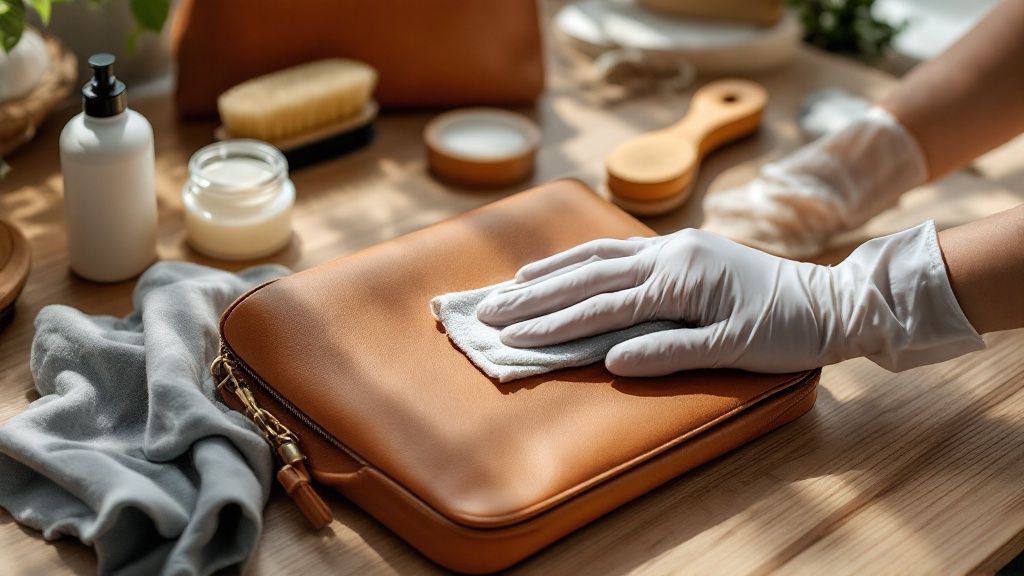Why Your Leather Purse Deserves Professional-Level Care
Your leather purse is more than just an accessory; it's an investment. With the right care, it can transition from a simple fashion item to a cherished heirloom, lasting for years to come. Think of it like a vintage car: regular maintenance keeps it running smoothly and preserves its value. Neglect, on the other hand, leads to costly repairs and a decline in its overall appeal. This holds particularly true in the UK, where the climate presents unique challenges for leather.
The damp British weather, with its unpredictable rain and fluctuating humidity, can damage untreated leather. Excess moisture can cause mildew, while dry periods can lead to cracking and stiffness. These conditions necessitate a more considered approach to leather care, going beyond the occasional wipe-down and establishing a regular maintenance routine.
Understanding the Science Behind Leather Degradation
Leather, being a natural material, is susceptible to degradation. Much like our skin, it requires nourishment and protection to retain its strength and suppleness. Without regular cleaning and conditioning, the fibers dry out, becoming brittle and prone to cracking. This not only affects the appearance of your purse but also compromises its structural integrity. For some helpful tips and tricks, check out this article: How to master the care of your leather bag.
The UK's significant leather goods market further emphasizes the importance of proper care. The UK imports a large volume of leather goods, including purses. In the second quarter of 2024 alone, these imports were valued at nearly £1.6 billion. This demonstrates the substantial investment Brits make in leather accessories and highlights the need for proper care. Maintaining these imported leather purses is crucial for extending their lifespan and retaining their value. Regular care not only prevents damage but also contributes to the overall sustainability of the leather goods market. You can find more detailed import statistics here: https://www.statista.com/statistics/465921/leather-goods-imports-quarterly-united-kingdom-uk/
Debunking Leather Care Myths
Many common misconceptions about leather care can actually be detrimental to your purse. Some believe that using harsh chemicals or leaving leather to "air out" in direct sunlight is beneficial. However, such practices can strip the leather of its natural oils, leading to dryness, fading, and premature aging.
Neglecting the hardware can also lead to tarnishing and corrosion, affecting both the functionality and appearance of your purse. By adopting correct cleaning and conditioning practices, you can preserve the beauty of your leather purse and extend its life, saving you money and ensuring years of enjoyment from your cherished accessory.
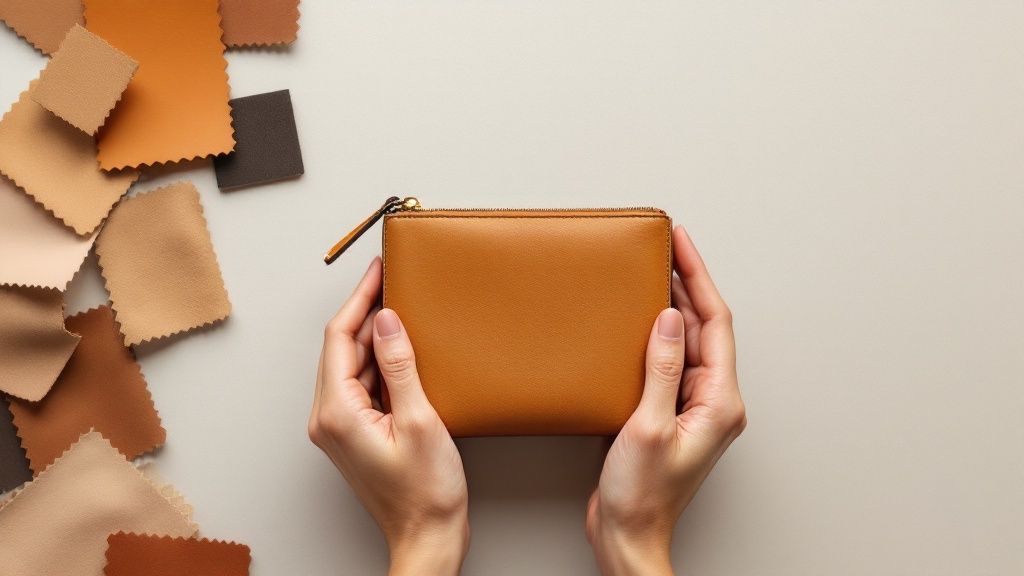
Building Your Leather Care Arsenal: Essential Supplies
Proper care for your leather purse can make all the difference. It's like painting a masterpiece – the right tools are crucial for achieving the desired result. This guide will walk you through assembling your leather care kit, focusing on products readily available in the UK.
Choosing the Right Cleaners and Conditioners
Not all leather cleaners are the same. Some deliver amazing results, while others fall short. For light cleaning, Saddle Soap is often enough. For stubborn stains, a dedicated leather cleaner might be necessary. Always test any new product on a hidden area first to check for discoloration or damage. For more leather care tips, you might find this article helpful: How to master the care of your elegant leather shoes.
Conditioning is essential for keeping leather supple and preventing cracks, especially with the UK's unpredictable weather. Remember, different leather finishes, like patent leather and suede, need specific conditioners.
Microfibre Cloths and Other Essential Tools
High-quality microfibre cloths are a must-have for leather care. They gently remove dirt without scratching. Cheaper alternatives can leave lint or even cause abrasions.
Other helpful tools include a soft brush for dusting, cotton swabs for crevices, and a small bowl for mixing solutions. Avoid using household products like baby wipes – they may contain chemicals that can damage the leather over time.
Budget-Friendly Alternatives
Building a great leather care kit doesn't have to be expensive. A simple mix of mild soap and water can clean many types of leather effectively. Oils like neatsfoot oil (used sparingly and with caution) can also condition leather.
However, for delicate hardware or hard-to-reach spots, investing in specialized tools is a good idea. These tools prevent damage and extend the life of your purse, making them a worthwhile investment in the long run.
To help you choose the best products for your needs, we've compiled a comparison of some essential leather cleaning supplies available in the UK:
Essential Leather Cleaning Products Comparison
A comparison of recommended leather cleaning supplies available in the UK market
| Product Type | Best For | Application Method | Price Range (£) | Where to Purchase |
|---|---|---|---|---|
| Saddle Soap | General cleaning, mild stains | Damp sponge | 5-10 | Online retailers, equestrian shops |
| Leather Cleaner | Tougher stains, deeper cleaning | Cloth or sponge | 10-20 | Online retailers, shoe repair shops |
| Leather Conditioner | Maintaining suppleness, preventing cracks | Cloth | 10-20 | Online retailers, leather goods stores |
| Microfibre Cloths | Cleaning, applying products | Wipe gently | 5-15 (for a pack) | Online retailers, supermarkets |
| Neatsfoot Oil | Conditioning, restoring dry leather | Apply sparingly with a cloth | 10-15 | Online retailers, hardware stores |
This table summarizes the key features and price ranges of various leather care products. Remember to choose products suited to your specific leather type and always test in an inconspicuous area first. Investing in the right supplies will help keep your leather purse looking its best.
The Step-by-Step Leather Purse Cleaning Method That Works
Revitalize your leather purse with this effective cleaning method, drawing upon insights from established leather brands and restoration professionals. We'll guide you through the process, ensuring your purse remains undamaged while achieving a thorough clean.
Preparing Your Leather Purse for Cleaning
Proper preparation is essential before starting the cleaning process. This helps prevent common mishaps and ensures optimal results. The infographic below illustrates the necessary pre-cleaning steps:
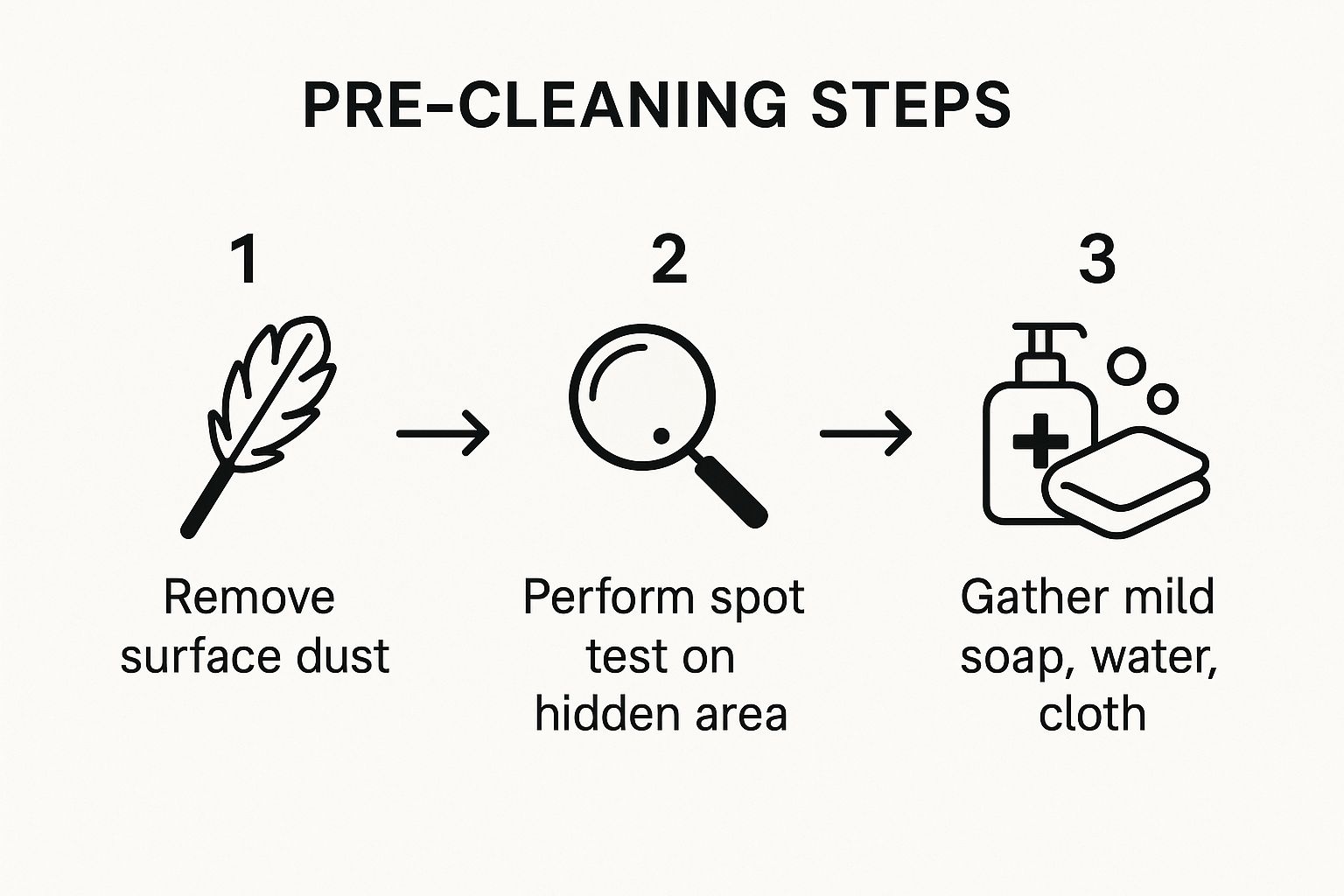
These three initial steps—removing loose dust, conducting a spot test, and gathering your supplies—form the basis of successful leather cleaning. By taking these precautions, you minimize the risk of damage and maximize the cleaning process's effectiveness.
Cleaning the Leather Surface
Begin by gently removing surface dust with a soft brush or microfiber cloth. This prevents dirt from becoming embedded in the leather during cleaning. Next, create a cleaning solution by mixing a small amount of mild soap with lukewarm water.
Dampen a clean cloth with the solution, ensuring to wring out excess water. Apply the solution to your purse using gentle, circular motions. Avoid harsh scrubbing, which could damage the leather's finish.
Concentrate on one section at a time, working methodically across the entire surface. Repeat the process for areas with stubborn dirt.
Cleaning the Hardware and Handles
Hardware and handles require special attention, as these are often the most soiled parts of a purse. Use a cotton swab dipped in the soapy solution to clean carefully around the hardware. Avoid direct contact with the leather.
This targeted approach helps prevent corrosion and maintain the hardware's shine. Handles, often the dirtiest part, benefit from the same gentle cleaning method. Carefully wipe them with the dampened cloth, paying attention to the stitching.
Avoid over-wetting the handles, as this can weaken the structure. Dry the hardware and handles thoroughly with a separate, clean cloth.
Drying and Conditioning Your Purse
After cleaning, wipe the entire purse with a clean, damp cloth to remove any residual soap. Next, dry the purse with a soft, dry towel. Avoid using direct heat or sunlight, which can dry out and crack the leather.
Allow the purse to air dry naturally in a well-ventilated space, away from direct sunlight and heat sources. Once dry, apply a suitable leather conditioner. This step is crucial for restoring moisture and maintaining the leather's suppleness.
Select a conditioner specifically designed for your purse's leather type. The fluctuating humidity in the UK can particularly affect leather, making regular conditioning essential. Learn more about the UK leather industry’s sustainability initiatives. You might be interested in: How to master the care of your elegant dark blue derby dress shoes. With consistent care, your leather purse will remain a stylish and durable accessory for years to come.
Conquering Stubborn Stains: The Advanced Techniques
Even with the most meticulous care, your beloved leather purse might encounter a stubborn stain or two. This section delves into tackling those panic-inducing marks – from the dreaded ink stain to the splash of red wine – offering advice gleaned from leather restoration experts.
Tackling Water Damage and Everyday Mishaps
Sudden downpours can catch us off guard. If your purse gets drenched, immediately blot it with a clean, absorbent cloth and let it air dry naturally. Avoid direct heat or sunlight, which can warp and damage the delicate leather. For persistent water stains that refuse to budge, a specialist leather cleaner might be necessary.
Oil marks are another common culprit on leather purses. Gently blot the stain with a dry cloth to absorb excess oil. Then, sprinkle cornstarch or talcum powder onto the affected area to help draw out the remaining oil. Let it sit for a few hours before brushing it off with a soft brush.
If you discover mould on your purse due to damp storage, swift action is crucial. Mix equal parts water and white vinegar. Lightly dampen a cloth with this solution and dab the affected area. Avoid over-wetting the cloth, as excess moisture can worsen the problem. Dry the area thoroughly and allow the purse to air dry completely in a well-ventilated space.
Dealing with Colour Transfer and Scratches
Colour transfer from denim, especially onto lighter-coloured purses, is a frequent frustration. A magic eraser can be surprisingly effective. Dampen it slightly and gently rub the affected area. Always test this on a hidden area first to ensure it doesn't discolour the leather.
Scratched corners, inevitable with daily use, can be treated with a leather filler or repair cream. Match the colour of your purse as closely as possible for a seamless repair. Apply the product sparingly and allow it to dry completely before buffing with a soft cloth.
Removing Stubborn Stains
For ingrained stains like ink or red wine, a specialized leather stain remover is often the best solution. Always follow the manufacturer's instructions and test the product on a hidden area first to prevent any unwanted reactions. For particularly expensive or delicate purses, professional cleaning may be the safest and most effective route. Explore Feinheit’s collection of luxury leather goods.
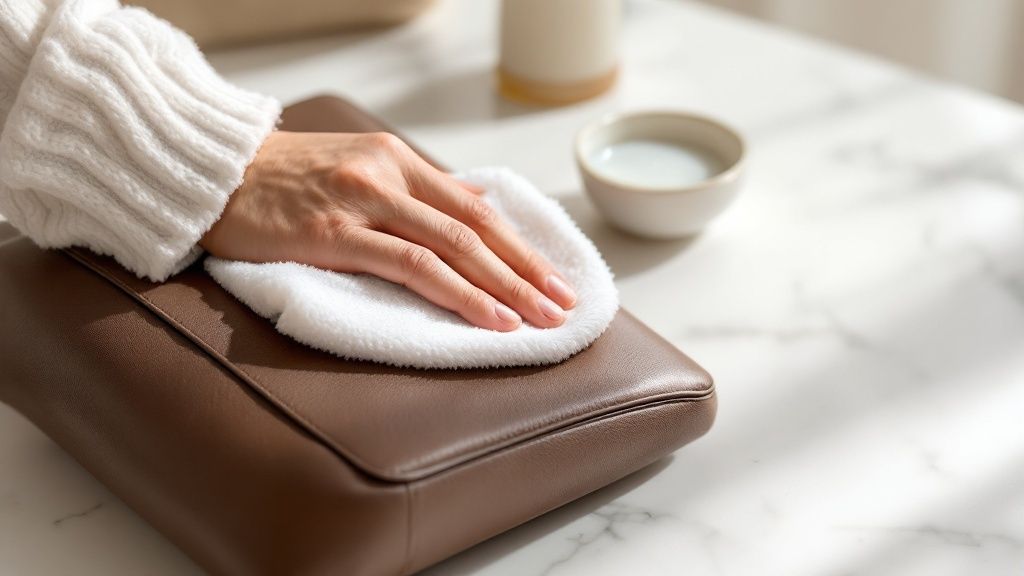
To simplify the stain removal process, we've compiled a handy guide below. It outlines the necessary products and techniques for addressing common purse stains, along with preventive measures to help you avoid them in the future.
Stain Removal Guide for Leather Purses
| Stain Type | Required Products | Removal Technique | Prevention Tips |
|---|---|---|---|
| Water | Absorbent cloth | Blot immediately, air dry | Use a water-repellent spray |
| Oil | Dry cloth, cornstarch/talcum powder | Blot, apply powder, brush off | Avoid contact with oily substances |
| Mould | Water, white vinegar | Dab with solution, dry thoroughly | Store in a dry, well-ventilated area |
| Ink | Leather stain remover | Apply as directed, test first | Use a protective spray |
| Red Wine | Leather stain remover, salt | Blot, apply salt, then stain remover | Treat immediately |
| Denim transfer | Magic eraser | Dampen and rub gently | Use a protective spray |
| Scratches | Leather filler/repair cream | Apply sparingly, buff | Avoid rough surfaces |
This table provides a quick reference for common stain emergencies. Remember, patience and the correct technique are essential for successful cleaning. Knowing how to effectively clean your leather purse can save you money and keep your favourite accessory looking its best, preserving its beauty for years to come.
The Art of Conditioning: Nourishing Your Leather Investment
Beyond simply cleaning your leather purse, conditioning is crucial. This often-overlooked practice is the secret to leather that ages gracefully, developing a rich patina over time instead of deteriorating. Think of it like skincare: cleansing removes dirt, but moisturizing keeps your skin healthy and supple. Conditioning does the same for leather.
Understanding Your Leather Type and Choosing the Right Conditioner
Just as different skin types require specific care, different leather types benefit from tailored conditioning. Full-grain leather, known for its durability, thrives with richer conditioners. More delicate leathers, such as lambskin, require lighter formulations. Choosing the right conditioner is paramount to avoid clogging the pores or causing discoloration. For example, a heavy conditioner on delicate leather could leave it greasy and attract dirt.
Applying Conditioner: Less Is More
The application technique is as important as the conditioner itself. Apply a small amount of conditioner to a clean, soft cloth and work it into the leather using gentle, circular motions. This ensures even absorption and prevents saturation. A little goes a long way. Too much conditioner can leave a greasy residue and attract dust, negating the benefits. The UK is home to specialized services like The Handbag Spa, which caters to high-end brands, highlighting the importance of proper care for luxury purses. Discover more insights about luxury handbag care.
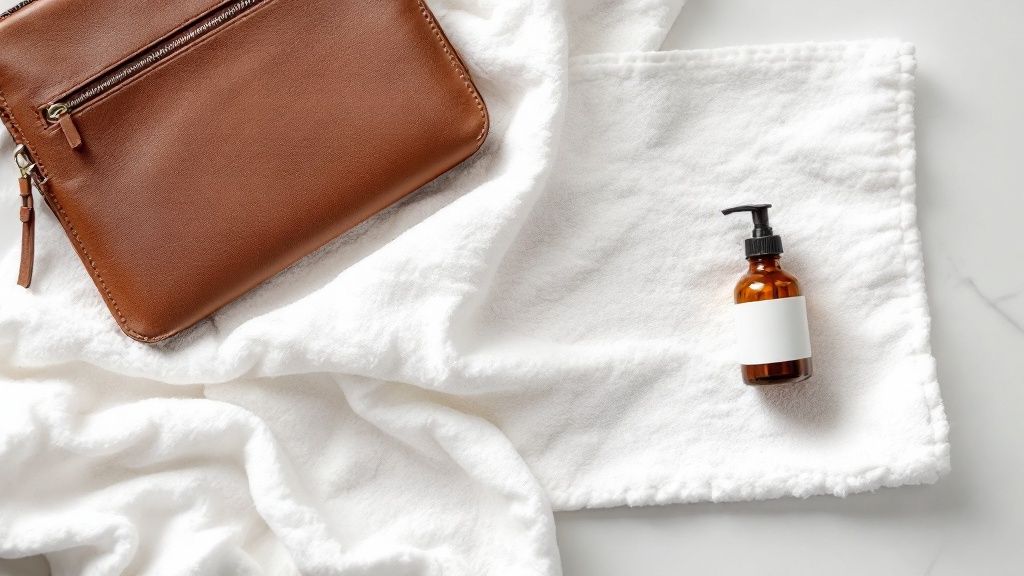
Seasonal Conditioning and Protection From the UK Climate
Britain's ever-changing weather, from damp winters to occasional summer heatwaves, requires adjusting your conditioning routine. During drier months, more frequent conditioning helps prevent the leather from drying out and cracking. In humid conditions, less frequent, lighter applications prevent over-saturation. You might be interested in how to care for a Lucia leather shoulder bag. Leather care can be seen as protecting an investment, similar to strategies to protect assets from lawsuits.
Identifying Dehydration and Protecting Your Investment
Knowing the signs of leather dehydration is key to preventing lasting damage. Dry, stiff leather, or the appearance of small cracks, indicates the need for immediate conditioning. Protecting your freshly conditioned purse from UV damage and sudden rain showers is also vital. A water-resistant spray, readily available in UK shops, can shield your purse from the unpredictable British weather. This proactive approach ensures your leather investment remains supple, vibrant, and ready for anything.
When to Call the Professionals: UK Leather Care Services
Even with the most attentive home care, your leather purse will eventually need a professional touch. Knowing when to DIY and when to seek expert help is vital for preserving its beauty and value. This guide explores UK leather care services, helping you find reputable specialists and understand the process.
Recognizing the Need for Professional Help
Regular cleaning and conditioning are great for everyday wear and tear. However, serious issues like deep scratches, tears, or water damage require professional care. Likewise, stubborn stains resisting home remedies, or vintage purses needing special attention, benefit from expert intervention. DIY attempts at complex repairs can worsen the damage and decrease the purse's value. To keep your leather supple, use a high-quality leather conditioner. For natural alternatives, consider the benefits of Tsubaki Oil.
Finding and Evaluating Leather Care Specialists in the UK
The UK has a rich history of leather craftsmanship, with skilled artisans throughout the country. Finding a reputable professional requires research and diligence. Seek established businesses with positive testimonials and reviews. Professional leather craft organizations can offer helpful recommendations. Request examples of previous work or references. Check out our guide on How to master the care of your elegant formal black derby dress shoes.
What to Expect: Services and Price Ranges
Professional leather care services include a variety of treatments. Basic cleaning and conditioning are standard. More specialized services include color restoration, structural repairs, and antique leather revitalization. Prices depend on the service complexity and the specialist’s experience. Basic cleaning may cost between £20-£50, while extensive restoration can start at £100 and go much higher. Get several quotes to compare services and prices.
Preparing Your Purse and Asking the Right Questions
Before handing your purse over, empty its contents and remove any detachable straps. When contacting a specialist, ask about their experience with your purse's specific leather type and recommended treatments. A true professional will offer detailed explanations and address your concerns, helping you make informed decisions. This also helps avoid unnecessary upselling.
Elevate your style with the perfect complement to your well-cared-for purse at TheFeinheit.com. Browse luxury brands and experience premium fashion and accessories. We offer free global shipping and subscriber discounts.

